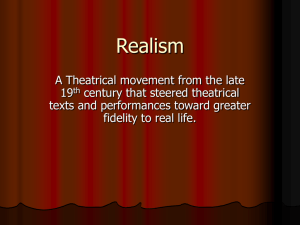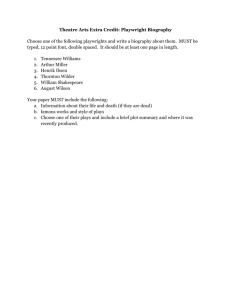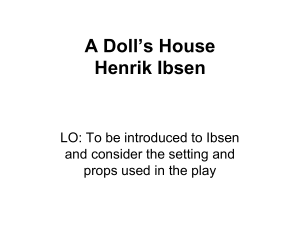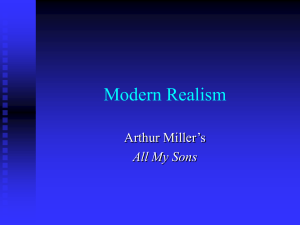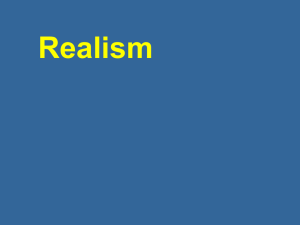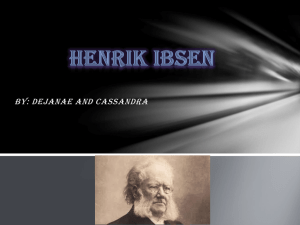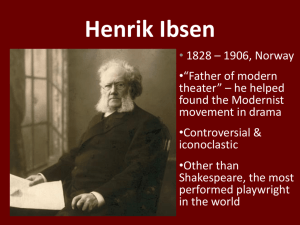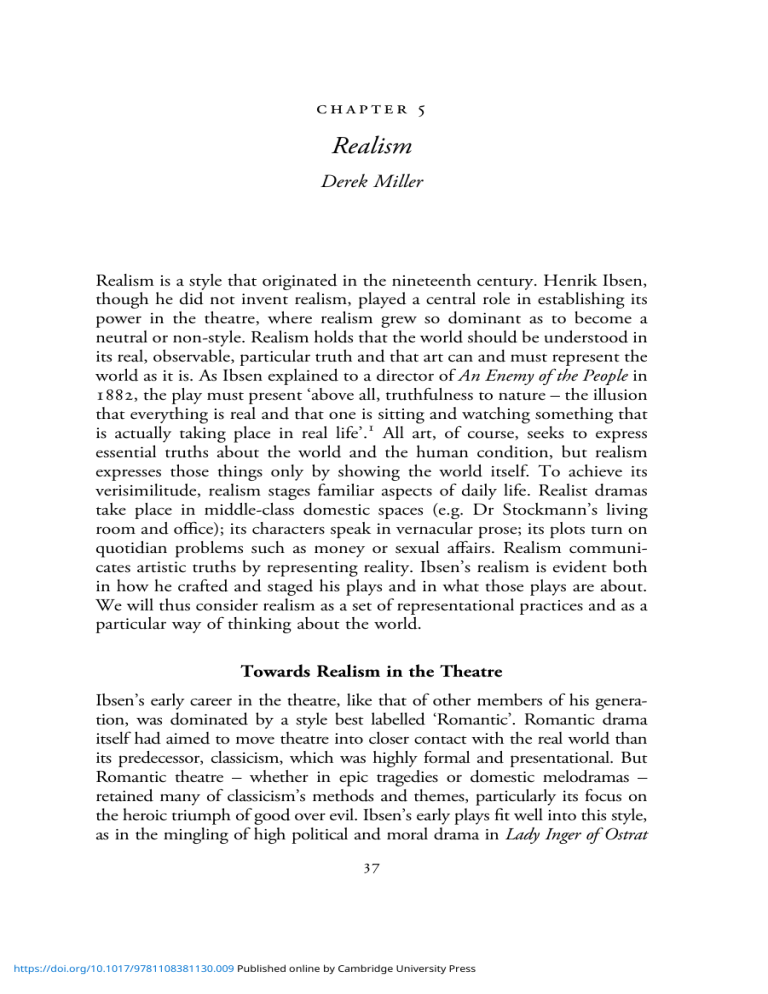
Realism Derek Miller Realism is a style that originated in the nineteenth century. Henrik Ibsen, though he did not invent realism, played a central role in establishing its power in the theatre, where realism grew so dominant as to become a neutral or non-style. Realism holds that the world should be understood in its real, observable, particular truth and that art can and must represent the world as it is. As Ibsen explained to a director of An Enemy of the People in , the play must present ‘above all, truthfulness to nature – the illusion that everything is real and that one is sitting and watching something that is actually taking place in real life’. All art, of course, seeks to express essential truths about the world and the human condition, but realism expresses those things only by showing the world itself. To achieve its verisimilitude, realism stages familiar aspects of daily life. Realist dramas take place in middle-class domestic spaces (e.g. Dr Stockmann’s living room and office); its characters speak in vernacular prose; its plots turn on quotidian problems such as money or sexual affairs. Realism communicates artistic truths by representing reality. Ibsen’s realism is evident both in how he crafted and staged his plays and in what those plays are about. We will thus consider realism as a set of representational practices and as a particular way of thinking about the world. Towards Realism in the Theatre Ibsen’s early career in the theatre, like that of other members of his generation, was dominated by a style best labelled ‘Romantic’. Romantic drama itself had aimed to move theatre into closer contact with the real world than its predecessor, classicism, which was highly formal and presentational. But Romantic theatre – whether in epic tragedies or domestic melodramas – retained many of classicism’s methods and themes, particularly its focus on the heroic triumph of good over evil. Ibsen’s early plays fit well into this style, as in the mingling of high political and moral drama in Lady Inger of Ostrat https://doi.org/10.1017/9781108381130.009 Published online by Cambridge University Press and The Vikings at Helgeland. Those plays offered audiences clear moral conflicts and shallow but clearly delineated characters. Romantic drama also relied on old-fashioned plot devices: coincidences, long-lost children, misidentifications. Authors such as Eugène Scribe used these devices with supreme craft in the pièce bien faite (well-made play), which surpassed classicism in its superior internal logic and structure, and influenced many of Ibsen’s plots. Realism, however, extended Scribe’s method by further integrating plot and character, while rejecting Romanticism’s moral clarity in favour of ambiguity and psychological complexity. Ibsen’s realist phase began with Pillars of the Community and continued through his final works, though his style is often mixed. Some of his earlier plays share characteristics with the fully fledged realist dramas. (For example, The League of Youth is written in colloquial prose dialogue.) And many of his later plays present a more heightened version of reality than a strictly realist approach might require. But, fundamentally, his last dozen plays provide a rich – and extremely influential – example of how theatre can and should attempt to depict real life. By the time Ibsen wrote his realist dramas, realism had been well established and debated, particularly in France, where the first great wave of realist art appeared in the novel. Honoré de Balzac, Stendhal, and Gustave Flaubert all wrote novels of contemporary domestic life, thick with psychological insights and cluttered with the trappings of bourgeois respectability. While realism’s triumph now seems inevitable, many contemporary reviewers used the term pejoratively. To a generation raised on an art praising lofty ideals, realism’s obsession with everyday life in all its physical specificity seemed vulgar and sordid. Some of this perceived sordidness was a function of the plays’ subject matter, exemplified in Ibsen’s oeuvre by the incestuous and syphilitic Alving family in Ghosts, which revolted some critics and audiences. But even admirers noted something unpleasant about the sheer ordinariness of Ibsen’s theatrical worlds. Henry James cited Ibsen’s ‘recurrent ugliness of surface’, which, even more than the plays’ political content, served as ‘proof of [Ibsen’s] fidelity to the real’. Thus Ibsen’s theatre diverged from Romantic drama in the complexity and domesticity of its plots, while also looking and sounding significantly different from its predecessors in its pursuit of verisimilitude on stage. Realism As Technique We can locate Ibsen’s realist style most precisely in his approach to dialogue, his visual sensibility (including his use of objects) and his rich https://doi.org/10.1017/9781108381130.009 Published online by Cambridge University Press Realism characterization. Consider dialogue. Two of Ibsen’s great middle period epics (Peer Gynt and Brand) were written primarily in verse. They marked the work of a mature dramatist and poet, but also one committed to a high literary style. The dramas that followed were all in prose. His prose plays not only discarded rhyme and metre, they also mostly eliminated the technical apparatus of heroic verse drama such as asides and monologues. Ibsen’s realist dialogue avoids, too, the pomposity found in the historical plays. When critic and translator Edmund Gosse suggested that Ibsen’s last epic, the ‘world historical drama’ Emperor and Galilean, should have been written in verse, Ibsen countered that only prose allowed him to situate the tragedy among real human beings. In the modern tragedies, Ibsen’s realist prose is a modern vernacular speech recognizably like the language of everyday middle-class Norwegians. (That language, of course, was lexically Danish, inflected by Norwegian vocabulary and idioms and with a marked pronunciation.) True, Ibsen’s writing still retained a distinctly theatrical quality; his dialogue is often poetic and always carefully crafted. In IngaStina Ewbank’s description, ‘Ibsen’s language takes us under the photographic surface of realism’ and exposes the plays’ ‘spiritual’ landscapes. But his language is also true dialogue: characters do not make grand pronouncements, but fight and plead with and seduce each other just as people do. While realist dialogue sounds like people speaking, realist characters also live in a far more physically detailed stage space than that occupied by their Classical or Romantic predecessors. Alexandre Dumas fils La Dame aux Camélias, for example, is set in nebulous non-spaces: a room in the house of Camille, a room in a country house. Ibsen’s rooms are specific places: The grand former gallery on the first floor of the Rentheim house. The walls are covered with old tapestries depicting hunting scenes, shepherds and shepherdesses, all in faded, bleached-out colours . . . A large carved oak writing table covered with books and papers . . . A sofa with a table and chairs. The furniture is all in the stiff Empire style. The precise trappings of bourgeois domesticity furnish these stage directions, each chosen, in production, to mimic the style that one finds in one’s own home. And those trappings are not simply decoration, they have meaning: the faded tapestries indicate John Gabriel Borkman’s former glory; the ‘stiff’ furniture style mimics Borkman’s own rigidity. Stage properties performed a similar signifying function. If a Romantic drama relied on a prop, as in Scribe’s Le verre d’eau, the prop served as a simple device to advance the plot. Ibsen’s props reveal character. When https://doi.org/10.1017/9781108381130.009 Published online by Cambridge University Press Nora Helmer hides her macaroons or Hedda Tesman mocks her husband’s slippers, the characters’ relationship to the props illuminates behaviour and psychology. The physical world of Ibsen’s realism was thus thick with meaningful objects, objects that anticipate and, in some sense, make inevitable the tragedies to come (e.g. Hedda’s pistols). Realist dialogue and scenery and props all helped, fundamentally, to create more richly realistic characters. Ibsen’s characters have deep, complex psychologies. Depth does not mean, as it did in many melodramas, simply a guilty secret. (For instance, Mathias in The Bells hides the murder he committed many years ago). An Ibsen heroine’s past is not simply hidden, but inscrutable even to herself. To perform these roles actors developed new techniques, particularly new relationships to the play text. ‘The [Ibsen] actor had to detect past events which could only be revealed through words . . . and then he had to convey the relationship between that past text and the present action demanded by it,’ explains Gay Gibson Cima. Understanding an Ibsen character required studying not only one’s own lines, but the entire play. As Ibsen advised Sophie Reimers as she prepared to play Rebekka West, ‘carefully take note of what the other characters say about Rebekka’ and ‘see the character’s position in, and in relation to, the whole work’. Ibsen was explaining, in other words, that character in his plays arises from the thick entanglement of plot, dialogue and environment that defined the realist technique. Realism As Idea Ibsen’s realism represented the lives of the contemporary European middle class, the bourgeoisie. Prior to realism, modern life was primarily a proper setting for stage comedy, but not for tragedy. Ibsen made the middle-class domestic space tragic. It bears underlining that the real world Ibsen built on stage assumed that his audience would recognize their homes in his stage sets, their problems in his characters’ troubles. Directors pursuing Ibsen’s realism observed scenic details scrupulously. For instance, one critic admired Konstantin Stanislavski’s production of Ghosts for providing a perfect study of ‘a typical family home in the far North – with all its curiosities, down to the arrangement of the rooms and their furnishings’. Audiences saw themselves in the plays, recognized their furniture, their habits, their tastes. The conflicts in Ibsen’s realist dramas hinge on humansized difficulties: a lack of money (due to illness or poor investment); a sexual affair; thwarted ambition. No affairs of state arise, as they did in his earlier, Romantic dramas. Audiences did not need to extend their https://doi.org/10.1017/9781108381130.009 Published online by Cambridge University Press Realism imaginations to identify with the problems of Ibsen’s characters. And the realist performance style, which put characters in places like their own homes, speaking a language like the one they spoke every day, enhanced that sense of identification. Even as Ibsen’s dramas presented a recognizable simulacrum of the world in which his audience lived, his plays also took up reality as a theme. Many characters undergo a process of disillusionment that leads them to confront the true, often tragic reality of their lives. Nora Helmer exemplifies the disillusionment common to Ibsen’s protagonists when she realizes that Torvald will not heroically sacrifice himself for her, as she imagines herself to have done for him. A Doll’s House, in some sense, thus hinges on Nora’s discovery that she is not in an ideal play, but in fact lives in a real world, a world without heroes, a world she does not understand. Because so many of Ibsen’s plots hinge on such disillusionment, Ibsen became identified as an anti-Idealist, pro-realist philosopher. Irish critic and playwright Bernard Shaw, in his influential essays on Ibsen published as The Quintessence of Ibsenism, played an outsized role in defining Ibsen’s philosophical realism. Ibsen, in Shaw’s reading, insists on characters whose ‘conduct must justify itself by its effect upon life and not by its conformity to any rule or ideal’. To be an Ibsenite realist, you must negotiate each situation as a unique moral challenge, rather than make decisions based upon a given set of expectations or rules for behaviour. Realism’s meaning on stage also intersected with late-nineteenthcentury liberal politics, particularly through the closely related artistic movement known as naturalism. Critics describe Ibsen as both a realist and a naturalist; the two categories overlap significantly and are not reliably distinguishable. It may be useful to think of realism as a particular theatrical strategy encompassing those staging techniques noted above, and of naturalism as a set of political ideas that realist theatre often (but not always) helped to convey. Naturalism, as defined most fully by Émile Zola, dramatizes the array of structural forces that constrain people’s ability to control their lives. In showing those constraints, theatre should strive to present the world objectively, as a journalist might. Realism was thus a superb vehicle for naturalism’s worldview. Naturalism bore the influence of three major nineteenth-century intellectual paradigms: Charles Darwin’s evolutionary theory, Auguste Comte’s Positivist sociology and Karl Marx’s economic theories. Ibsen’s engagement with these ideas appears throughout the plays. A Doll’s House and Hedda Gabler present women struggling against a patriarchal social system. Osvald’s venereal disease in Ghosts and Hedvig’s blindness in The Wild Duck exemplify https://doi.org/10.1017/9781108381130.009 Published online by Cambridge University Press naturalist theatre’s thematization of biological heredity. And almost every Ibsen plot since Pillars of the Community hinges on money, from Nora Helmer’s desperate attempts to repay a loan to John Gabriel Borkman’s illicit financial speculation. Ibsen’s realism was deeply engaged with portraying, in an objective, realistic manner, the set of social forces that determined the course of modern life. It may be useful to demonstrate how realism, as a dramatic technique and as an idea, actually works in an Ibsen play. The Wild Duck is about Gregers Werle, who wishes to reveal to his old friend Hjalmar Ekdal the true paternity of Hjalmar’s daughter, Hedvig. Everyone else in the play insists that Gregers leave Hjalmar and his family to live with their illusions. With tragic irony, Gregers’s insistence that Hjalmar confront reality leads ultimately to Hedvig’s death. Thus Ibsen suggests that illusions, too, serve a useful purpose; reality is not an unalloyed good. The play is, of course, set in a realistic apartment, but one that includes a large attic space that is, itself, a kind of realist stage set of a forest. And Hjalmar’s profession as a photographer requires him both to represent reality (the photographic image) and to distort that reality with necessary illusions (the ‘touching up’ that the family undertakes to improve their photographs). These examples only begin to describe how The Wild Duck stages, in its plot, its setting, and its characters, the uneasy battle between reality and illusion. Realism beyond Ibsen For all his influence as a realist, Ibsen was far from original or alone in his use of realism. The French novel, as noted above, had established realism as a successful style by the s. Theatres such as the Prince of Wales in London and the Meiningen Ensemble were innovators in staging practices including the use of three-dimensional domestic scenery and motion-filled crowd scenes filled with individual characters, respectively. (The Meiningen company produced Ibsen’s own The Pretenders in Berlin in , presumably encouraging his theatrical imagination in a more realist direction.) Playwrights such as Alexandre Dumas fils pushed drama to address serious social concerns. Ibsen’s fellow playwright and critic Bjørnstjerne Bjørnson notably predated Ibsen in his fascination with realism, praising French dramatists in for their ‘current of naturalism . . . striving for truth’. And Bjørnson’s hugely successful play A Bankruptcy anticipated Pillars of the Community and represented an important embrace of realist staging and themes. Critic Georg Brandes advocated vocally for realism just as Ibsen’s own realist dramas appeared, https://doi.org/10.1017/9781108381130.009 Published online by Cambridge University Press Realism buttressing the playwrights’ efforts. Thus no single aspect of Ibsen’s realism was entirely novel or unexpected by the time it arrived on European stages in the late s, nor was Ibsen its sole practitioner or advocate. Yet Ibsen stands out as the exemplary realist in the theatre. His status derives in part from his ability to synthesize realism’s multiple representational techniques with more subtlety and sophistication than did his predecessors and competitors. But he also, for a confluence of reasons, achieved greater, more international, and more lasting success than, say, Bjørnson. The next generation of serious and influential dramatists then learned from (and often praised) Ibsen. Bernard Shaw not only wrote extensively and effusively about Ibsen, but also composed fundamentally Ibsenite plays throughout much of his long career, even setting an act of The Philanderer in a fictional ‘Ibsen Club’ that celebrates breaking social norms. One early assessment of leading naturalist playwright Gerhart Hauptmann notes that ‘the influence of Ibsen upon Hauptmann is so evident, that scarcely any critic of Hauptmann fails to mention it’. Eugene O’Neill, Lillian Hellman and Arthur Miller all carried forward, in some way, Ibsen’s theatrical project as they built a major dramatic tradition in the United States. To the extent that Ibsen remains (with Anton Chekhov) the major writer of realism, all domestic dramas – with their living rooms and props, their rich character psychologies, their complex family histories that reveal social transgressions – are essentially Ibsenite. Ibsen beyond Realism And yet, for all his fame as the great dramatist of bourgeois realism, there remains something ineffably strange, irrefutably unreal about Ibsen’s work. Brandes noted that the worlds Ibsen built on stage, despite their solidity, shimmered with a lingering uncertainty: ‘behind everything we feel Ibsen’s undermining scepticism with regard to the existing and accepted order of things’. This uncertainty arises partly from Ibsen’s symbolist tendencies, which grow increasingly evident in the later plays. (As Brandes wrote after The Master Builder’s premiere, ‘naturalism and symbolism have been harmonious partners’ in Ibsen’s plays from nearly the start of his career’.) These symbolist techniques create provocative tensions with the realist environment the characters occupied. According to some writers, the representational habits of realism even conflicted with the later plays’ mystical energies. For example, critics complained about early productions of John Gabriel Borkman in which the realist sets, both interior and https://doi.org/10.1017/9781108381130.009 Published online by Cambridge University Press exterior, conveyed ‘none of the [play’s] suggestive atmospheric power’. That sense of atmosphere pervades all of Ibsen’s work like a Dickensian London fog – felt more strongly in plays such as The Lady from the Sea, Little Eyolf or When We Dead Awaken, but present even in the stiflingly isolated Tesman household. The hint of unreality that undergirds, and occasionally threatens to undo, Ibsen’s realism originates, perhaps, in the theatricality of the real world Ibsen captured so brilliantly. More than any other realist playwright, Ibsen crafted characters who understand that how they live, the style of their lives, defines who they are. This is one key aspect of the bourgeois tragedy: a relentless demand to perform bourgeois life. And thus no matter how real the world Ibsen put on stage, how precise the characterizations, how colloquial the speech, that fictional world always demonstrated that the real world in which his audiences lived was, itself, a kind of illusion. Ibsen may as well have been writing about his own bourgeois life as about the stage when, on the eve of his great realist breakthrough, he explained that ‘The illusion I wished to produce was that of reality.’ Notes . Henrik Ibsen, Letter to H. Schrøder, December , quoted in Michael Meyer, Ibsen: A Biography (New York: Doubleday & Company, Inc., ), p. . . Henry James, ‘Henrik Ibsen’, in Essays in London and Elsewhere (New York: Harper & Brothers, ), p. . . Henrik Ibsen, Letter to E. Gosse, January , in John Nilsen Laurvik and Mary Morison (trans.), Letters of Henrik Ibsen (New York: Fox, Duffield; Company, ). . Inga-Stina Ewbank, ‘Ibsen’s Dramatic Language as a Link between His “Realism” and His “Symbolism”’, in Contemporary Approaches to Ibsen, vol. , ed. Daniel Haakonsen (Oslo: Universitetsforlaget, –), p. . . Henrik Ibsen, John Gabriel Borkman, in The Master Builder and Other Plays, trans. Barbara Haveland and Anne-Marie Stanton-Ife, ed. Tore Rem (New York: Penguin, ), p. . . Gay Gibson Cima, ‘Discovering Signs: The Emergence of the Critical Actor in Ibsen’, Theatre Journal : (), p. . . Ibsen, Letter to S. Reimers, March , in Ibsen on Theatre, ed. Frode Helland and Julie Holledge, trans. May-Brit Akerholt (London: Nick Hern Books, ), p. . . Quoted in Frederick J. Marker and Lise-Lone Marker, Ibsen’s Lively Art: A Performance Study of the Major Plays (Cambridge: Cambridge University Press, ), p. . https://doi.org/10.1017/9781108381130.009 Published online by Cambridge University Press Realism . Bernard Shaw, The Quintessence of Ibsenism. Now Completed to the Death of Ibsen (London: Constable and Company, Ltd., ), p. . . Bjørnstjerne Bjørnson, essay in Morgenbladet, December , quoted in Meyer, Ibsen, pp. –. . Millicent Stebbins, ‘The Influence of Ibsen upon Hauptmann’, MA thesis, University of Illinois Urbana-Champaign (), p. . . George Brandes, Henrik Ibsen; Björnstjerne Björnson, trans. Jessie Muir, revised ed. (London: William Heinemann, ), p. . . Quoted in Meyer, Ibsen, p. . . Alfred Polgar, reviewing Otto Brahm’s production, quoted in Marker and Marker, Ibsen’s Lively Art, p. . . Ibsen, Letter to E. Gosse, January , in Letters of Henrik Ibsen. https://doi.org/10.1017/9781108381130.009 Published online by Cambridge University Press
